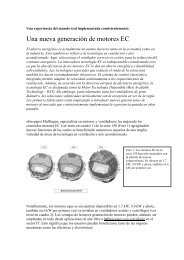Download [PDF] 2.3 MB - ebm-papst UK
Download [PDF] 2.3 MB - ebm-papst UK
Download [PDF] 2.3 MB - ebm-papst UK
You also want an ePaper? Increase the reach of your titles
YUMPU automatically turns print PDFs into web optimized ePapers that Google loves.
ACTIONBRAKEFigure 2 (left): Clearly visible, guardgrilles not only stand out visually, theyalso impede the air flow.with guard grilleinlet sidesingle fan@ 8900rpmwith guard grille inletside + outlet sideOverall Level 88.2 dB(A)/1pW 84.8 dB(A)/1pW 88.0 dB(A)/1pWTable 3a: Comparison of Sound Power Level; Fans with and without a guard grilleBecause of theintegrated rapid brakingthe fan can operate atoptimum efficiencytime, low-friction bearings operate in the fansto increase the energy efficiency and servicelife. Consequently, the energy stored in the rotormakes for long run-down times. If the rotation issuddenly stopped by an object or even a finger,the kinetic energy abruptly discharges. This leadsto damage or, in the worst case, injury. To preventthis, regulations stipulate the use of protectionagainst accidental contact with quickly accessiblefans, in other words, guard grilles (Figure 2). Preciselywith high-peformance fans, however, thisnegates a portion of the sophisticated aerodynamicproperties. The grille generates turbulenceand thereby noise and counterpressure, resultingin lower blower output. Thus the grille acts as anenergy dissipator, like a gently and continuouslyapplied brake. The higher speed here generateseven more additional noise (Table 3a, Figure 3b).Safety without external components Thenew approach proceeds from integrated rapidbraking via the fan drive. This means that nomore disruptive obstructions are implementedin continuous operation; the fan can operate atoptimum efficiency. This also reduces installationeffort and eases the installation. The principlebehind the wear-free brake is simple as well astried-and-tested: The motor becomes a generatorand the generated current is then converted intoheat. The technology offers various options forthe design. Higher outputs require external brakeresistors; small outputs use the motor windingsas a brake resistor by means of a short-circuitswitch. Therefore the fan experts were set thetask of optimally designing the ActionBrake tomeet the needs of the fans, while doing withoutexternal components wherever possible. Througha series of tests, the optimum variant was foundto be the short-circuit switch for the motor windings.Initially in this case, however, very large currentscan arise at high speeds by means of theinduction. This means that the windings have toendure a high but short-term heat load, and thecontrol transistors have to be designed for thesepulse currents. Additionally, high currents incoils always means there will be a strong (counter)magnetic field. Thus there is a danger of themagnets in the rotor demagnetising. These problemsare solved by a suitable selection of componentsand configuration of the magnets. Thereforethe brake lifting magnet operates as reliablyand as long as usual.If the operating voltage is switched off, theelectronics enter the braking mode. In doing so,they draw their power supply from the loaded filtercapacitor. If the voltage decreases, the capacitoris recharged by short charging pulses from the“brake generator”. This is done to maintain thefunction, and thus the activation of the short-circuittransistors of the electronics, until the rotor6techmag 01°2013


![Download [PDF] 2.3 MB - ebm-papst UK](https://img.yumpu.com/52907850/6/500x640/download-pdf-23-mb-ebm-papst-uk.jpg)



![[PDF] 22.3 MB - ebm-papst Argentina](https://img.yumpu.com/7645467/1/184x260/pdf-223-mb-ebm-papst-argentina.jpg?quality=85)